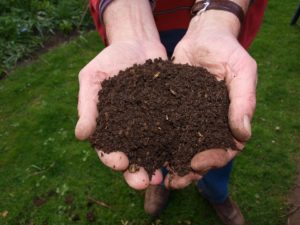
Compost contains nutrients that plants need for healthy growth.
Instead of discarding your food scraps and yard debris, why not put them to good use? Recycling organic material such as vegetable scraps and fallen leaves is an effective way to help plants grow while reducing waste. Known as composting, this natural process involves breaking down organic matter into simpler substances with the help of things like fungi and bacteria. Once broken down, compost can be added to soil, where it will deliver essential nutrients to your plants. Starting your own compost pile at home is easier than you think, and it will help feed your garden while cutting down on the amount of trash you throw away.
Step 1: Choose a Bin and Location
The first step is to set up a compost bin or choose to have an open pile. While open piles can be convenient, having a bin will help keep out animals. You can find compost bins at most garden stores, or you can build your own. Consider how much organic material you will be composting when deciding on the bin’s size. Once you have your compost bin, store it near your garden for easy access. The site should be in a warm area that does not receive full sun.
Step 2: Layer Brown Materials at the Bottom
Start your compost pile with a thick layer of coarse, brown materials, such as brush, twigs, or straw. Brown waste has a high concentration of carbon, which is essential for effective decomposition of organic materials. These brown materials at the base of your compost pile will also promote proper drainage.
Step 3: Add Composting Materials in Layers
Your composting materials should be added layer by layer. After the base of brown waste, add a thin layer of green waste. Green, nitrogen-rich waste may include green leaves, flowers, vegetables, fruit peels, tea leaves, and eggshells. Cover your thin layer of green waste with another layer of brown waste.
Try to keep the layers fairly equal. Too much brown waste can slow down the composting process, while too much green waste can lead to overheating. You’ll also want to avoid certain materials, such as animal waste, fish and meat scraps, glossy or coated paper, labels from fruits or veggies, coal-fire ash, dairy products, and fat, oil, or grease.
Step 4: Keep Your Compost Moist
Your compost pile should be kept damp, similar to a wrung-out sponge. You’ll want to avoid adding too much water to your compost, as this can result in a slimy mess and an offensive odor. Excess moisture can also slow down the natural decomposition process. But if you notice that your compost pile is not decreasing in size, it may be too dry and need water. Add a small amount at a time, mixing thoroughly until you’ve reached the desired moisture level.
Step 5: Turn Every Few Weeks
Turn the compost pile on a regular basis to maintain proper air circulation. When the organic materials have access to an adequate supply of oxygen, they are better able to break down. Mixing the compost about once a week can also keep odors at a minimum.
When your compost is finished, it will appear dark and crumbly. On average, it takes about four to six months to achieve finished compost.
